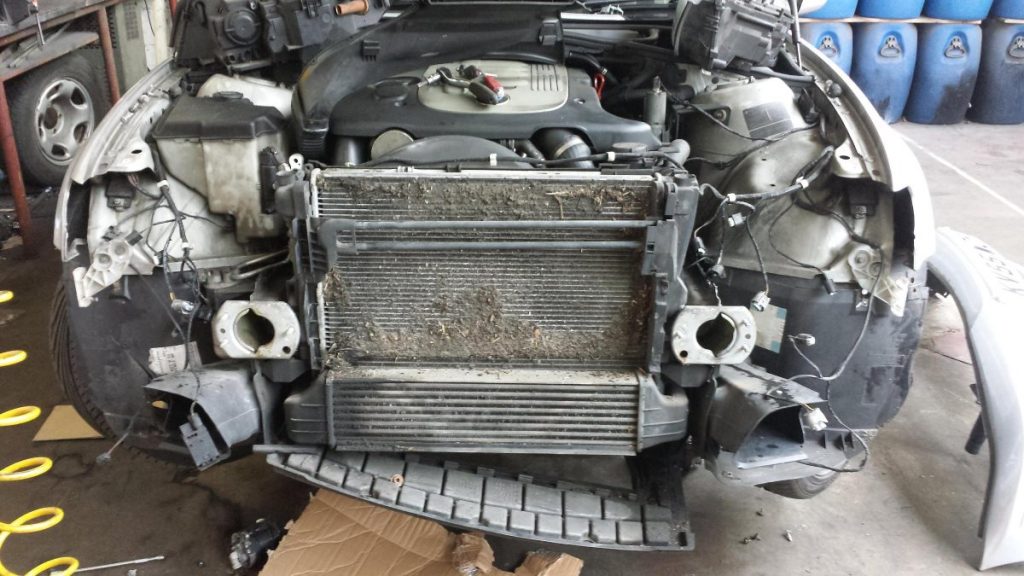The Common Signs of a Bad Car AC Condenser
The condenser is a major component of any air conditioning system. In fact, it can be considered the heart of the system, and a failing condenser directly impedes its efficiency and your ability to enjoy cool, fresh air while driving. The condenser can fail in many ways. Read on to learn the basic maintenance tips of the signs of a bad A/C condenser, the reasons for its malfunction and what to do about each scenario.
What Does The Condenser Do
The air conditioning system in your car requires a refrigerant for operation and consists of the compressor, condenser, evaporator, orifice tube, and an accumulator. The compressor compresses the refrigerant into a liquid. As the gas gets compressed, it heats up, and the high pressure forces the refrigerant to travel through the system to the condenser. The condenser features a section of coils that the cool air from outside passes over, thus transferring the heat from the compressed gas to the air. It’s also responsible for moving the now cooled refrigerant to the other components in the A/C system so that you get cold, dry and fresh air that’s rid of dust, debris and moisture.
How The A/C Condenser Can Fail
Clogs or Blockages

Condensers are subject to clogs over time due to the buildup of residue in the refrigerant, which eventually turns into a sticky paste that hinders the heat transfer that can take place from the hot refrigerant to the cool ambient air that gets blown over the condenser coil.
The second cause for a condenser malfunctioning is a blockage caused by debris. This is typically due to a worn compressor that is breaking apart and dispersing metallic internal parts throughout the entire system. This means that if you’re dealing with a blockage, you might need to replace not just the condenser, but also the failing compressor, the tubes, and the receiver/dryer or accumulator, since metallic debris has contaminated the whole system.
A blocked condenser can cause a problem called short-cycling, which makes the A/C unit cycle on and off rapidly and ineffectively instead of optimal operation. This abnormal cycling will cause more wear and tear on all components, thus you might have to replace many parts at the same time or replace the whole A/C unit prematurely.
Faulty or Worn Parts
The condenser itself consists of multiple parts: the coil, the motor, the fins, the condenser relay switch, the run capacitor, plus tubes and seals. If these parts become dirty or become worn with old age, your condenser might lose its function. Sometimes you can clean or replace the faulty part itself, sometimes you’ll need to replace the whole condenser or the entire A/C unit. When to repair and when to replace your faulty condenser will be discussed further below.
Leaks
Another reason for a failing condenser is leaks. The condenser seals and tubes are prone to normal wear and tear; they can crack or break. Another possibility is damages from physical impact by road debris or rocks, as the condenser is located near the front of a car. A leak in the condenser can lead to a low refrigerant charge and thus poor A/C performance, since the system relies on the refrigerant for operations.
Signs of a Failing Car A/C Condenser
- Loud, Abnormal Noises Coming From the A/C
- Air Conditioning Is Less Cold Than Usual: A reduction in cooling capacity means something is not working as it’s supposed to. If the condenser is dirty, clogged, blocked or any condenser component is damaged or failing in any way, the refrigerant flow may be restricted.
- Air Conditioning Doesn’t Work At All: Another sign that the condenser is faulty is the A/C doesn’t work at all. Sometimes when the condenser is failing, it can cause the pressures in your A/C system to be too high. When this happens, your car will automatically shut down the A/C to prevent further damage. Also, a leaking condenser will cause low refrigerant charge, which might not be sufficient to operate the A/C unit at all.
- Leaks: You normally won’t be able to notice condenser leaks by eyes. If you look very, very closely, all you’re likely to see is a faint outline of refrigerant oil. Sometimes, for older cars, a trace dye that is bright green in colour is added to the A/C system for easily detecting condenser leaks (your vehicle operates on many fluids, each has a distinct colour, so don’t mistake them).
When to Repair Or Replace Your AC Condenser
Clean the dirty parts:
- A dirty or clogged condenser: If your condenser is clogged with dirt or anything that’s interfering with the unit, simply give it a thorough cleaning to restore the unit’s optimal performance.
- Dirty coil: The coil is the part that the cool ambient air gets blown over, so over time, it is also prone to collecting dust and other contaminants in the air. You just have to clean off debris from the coil to restore the condenser’s capability.
If you’re lucky, you can just replace certain faulty components as follows:
- Faulty Motor: A faulty motor needs to be replaced. But note that you must check your owner’s manual for the correct replacement motor to avoid causing even more damage to your air conditioning unit.
- Bad condenser relay switch: easy replacement
- Bad run capacitor: easy replacement
Sometimes, you’re less lucky. If you’re dealing with the following problems, you’ll need to replace the entire condenser itself, or worse, the entire air conditioning unit:
- Condenser blockages: As mentioned above, a blockage caused by metallic debris from a failing compressor is a major issue and most of the time, you may have to replace more than the condenser itself or worse, replace the whole air conditioning unit.
- Condenser leaks: If the condenser is leaking excessively, you’ll need to replace the entire condenser as it’s not possible to replace cracked or broken seals or tubes.
- Damaged coil: A damaged coil is very hard, expensive and time consuming to repair, unless your coil is still under warranty. Otherwise, people usually replace the entire air conditioning unit, which is quicker and cheaper.














